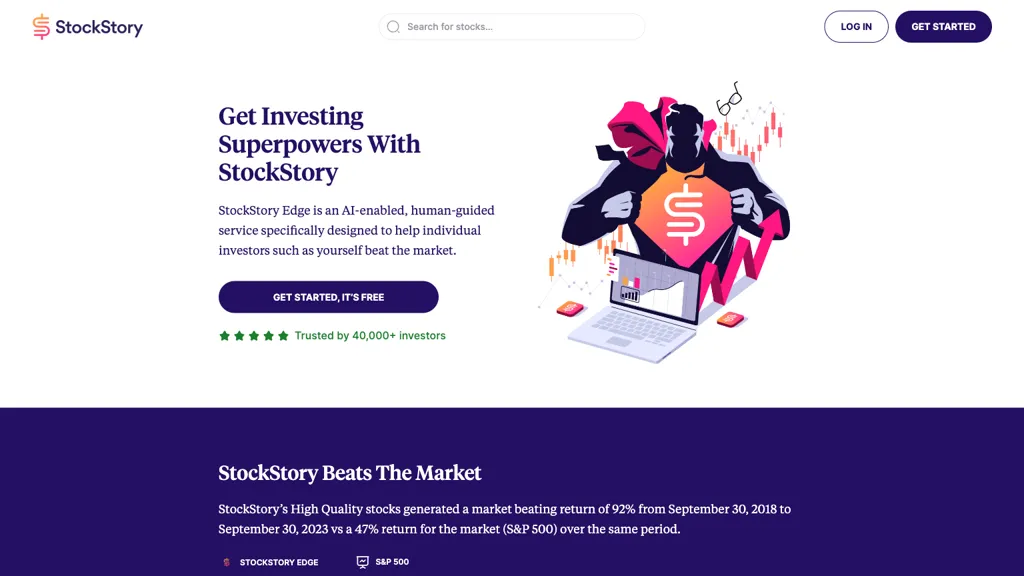Market coverage plays an important aspect in evaluating an AI stock-predicting/analyzing trading platform because it will determine your access to a wide array of financial markets. Market coverage is essential because it permits you to diversify your portfolio, learn about the world's markets, and adjust different trading strategies. Here are 10 strategies to help you assess the market coverage offered by these platforms.
1. Evaluate Supported Asset Classes
Stocks: Make sure that the platform is able to cover the major exchanges for stocks (e.g., NYSE, NASDAQ, LSE, HKEX) and also includes small-cap, large-cap and mid-cap stock.
ETFs: Check if the platform can support a broad variety of ETFs that offer a wide exposure to different regions, sectors, or themes.
Options and futures. Make sure the platform includes derivatives like options, futures and other leveraged instruments.
Commodities and Forex. Find out whether there are any forex pairs available, as well as precious metals, energy commodities, and agricultural commodities.
Cryptocurrencies: Check if the platform supports major cryptocurrencies (e.g., Bitcoin, Ethereum) and altcoins.
2. Verify coverage in your area
Global markets: The platform should include major global markets like North America and Europe, Asia-Pacific and emerging markets.
Regional focus: Check if your platform has a specific market or market that aligns with your trading needs.
Local exchanges - Examine to see if there are local or regional exchanges available that relate to your location and strategy.
3. Comparing Real-Time Data to Delayed Data Delayed Data
Real-time information is vital to make quick decisions especially in trading that is active.
Delayed information: Determine whether the delayed data is available for free or at a discounted price that could be sufficient for investors who have an eye on the long term.
Data latency: Check whether the platform is able to reduce latency for real-time data feeds specifically in high-frequency trading.
4. Review the Historical Data available
Depth historical data: Check that the platform can provide extensive historical information (e.g. more than 10 years of data) for backtesting and analysis.
Check the granularity of historical data.
Corporate actions: Check for evidence that data was reported in the past. Dividends as well as stock splits and any other corporate actions should be included.
5. Check the Market Depth and Place an Order Books
Data Level 2: Make sure the platform offers Level 2 (order book depth) to provide better price discovery.
Find out if there is a real-time bidding system and spreads of asking. This will guarantee that the pricing is correct.
Volume data: Make sure that your platform has comprehensive volume data that can be used to study market liquidity and market activity.
6. Assess Coverage for Indices and Sectors
Major indices: Make sure the platform is able to handle major indices (e.g., S&P 500, NASDAQ 100, FTSE 100) for benchmarking and index-based strategies.
Data specific to a sector for targeted analysis make sure the platform has data specific to a specific sector (e.g. technology, healthcare or energy).
Customized indexes. Check if your platform permits you to create and track custom indexes based on the criteria you define.
7. Assess the impact of integration with News and Sentiment
News feeds : Ensure you use a platform that incorporates live news feeds, preferably from reliable media outlets (e.g. Bloomberg and Reuters) to cover the most important market events.
Sentiment analysis: Find out whether there are tools to perform sentiment analysis that are based on news articles, or other data sources.
Strategies that are based on events (e.g. earnings announcements or economic reports): Check if your platform allows trading strategies that rely on events.
8. Test for Multi-Market Trading
Cross-market Trading: Check that the system allows you to trade across multiple market segments and asset classes using a unified interface.
Currency conversion: Find out if your platform supports multi-currency trading and automatic currency conversion.
Support for various time zones It is important to ensure that the platform supports trading on global markets in different time zones.
9. Review Alternative Data Sources
Alternative data: Check whether the platform is able to integrate other sources of data (e.g. satellite imagery or web traffic, credit card transactions) for unique insight.
ESG Data Find out whether there are any environmental, social or governance (ESG data) on the platform for socially-responsible investing.
Macroeconomics data: for a more basic analysis, ensure that the platform is stocked with macroeconomic indicators, such as GDP (gross domestic product) inflation rates, GDP and interest rates.
Review Market Reputation and User Reviews
User reviews: Examine the feedback of users to evaluate the platform's market coverage Usability, reliability, and coverage.
Industry reputation: See whether the platform has been praised for its market coverage by industry experts or awards.
Case studies: Search for reviews or case studies that demonstrate the platform's effectiveness in specific assets or markets.
Bonus Tips
Trial time: You can try the demo, trial, or a free trial to test the coverage of markets as well as the quality of data.
API access: Ensure that the API on the platform permits you to programmatically access market data to perform custom analysis.
Customer Support: Ensure that the platform is able offer support for any issues related to data or market problems.
By using these tips using these tips, you will be able to precisely assess the coverage of an AI stock prediction/analyzing trading platform. You can then choose a trading platform that offers you the market and the data you require for successful trades. Market coverage that is comprehensive allows you to diversify your portfolio, look for new opportunities, and adapt to market conditions that change. View the most popular best ai stock trading bot free blog for site examples including ai for trading, ai investing app, ai for stock predictions, ai investment app, options ai, ai stock picker, investing ai, ai stock trading, ai investing app, ai stock trading bot free and more.

Top 10 Ways To Evaluate The Risk Management Of Stock Trading Platforms That Use Ai
A trading platform that uses AI to predict/analyze stocks must be equipped with a strong risk management process. This will safeguard your capital, and help minimize any potential losses. Platforms that have robust risk management tools can assist you in navigating turbulent market conditions and make informed choices. Here are the top ten tips to evaluate the risk management capabilities of these platforms.
1. Examine Stop-Loss and Take Profit Features
Customizable level: You should be able to modify the levels of take-profit and stop-loss for individual trades and strategies.
Make sure to check the platform whether it is compatible with trailing stopped which adjusts automatically when the market moves your way.
If the platform provides the option of a stop-loss order that guarantees the position will be closed to the price specified in volatile markets, you can be confident of a profitable trade.
2. Assess Position Sizing Tools
Fixed amount: Ensure that the platform lets you define positions based on a certain amount of money that is fixed.
Percentage of your portfolio: See whether you are able to set position sizes in percentages of your portfolio total to control risk in a proportional manner.
Risk-reward Ratio: Ensure that the platform allows for setting risk-reward levels for each individual.
3. Look for Diversification Support
Multi-asset trading : Ensure that the platform you choose to use allows you to trade across different asset classes, like ETFs, stocks and options. This can help you diversify your portfolio.
Sector allocation: See if the platform provides tools to monitor and manage the exposure of sectors.
Geographic diversification - Verify that the platform supports trading on international markets. This will allow you to diversify geographical risk.
4. Evaluation of leverage and margin controls
Margin requirements - Ensure that the platform explains the requirements for margins clearly.
Check if your platform allows you to limit leverage to manage risk exposure.
Margin calls: Make sure you get prompt messages from the platform to prevent account liquidation.
5. Assessment of Risk Analytics and Reporting
Risk metrics: Ensure that the platform includes the most important risk-related metrics like Value at Risk, Sharpe ratio and Drawdown, for your portfolio.
Scenario assessment: Find out if you can simulate different market scenarios using the platform to assess the potential risk.
Performance reports: Make sure the platform provides you with detailed information on the performance of your investments, including returns that are adjusted for risk.
6. Check for Real-Time Risk Monitoring
Monitoring your portfolio: Make sure that the platform provides real-time tracking of the risk exposure to your portfolio.
Alerts: Check if you receive real-time alerts for events that are risk related (e.g. stop-loss triggers and breach of margins).
Risk dashboards - Examine to see if the platform you are using offers customizable risk dashboards. This will provide you with more information about the risks you are facing.
7. Evaluation of Backtesting and Stress Testing
Stress testing: Make sure the platform you choose allows you to test your portfolio and strategies under the most extreme conditions of the market.
Backtesting: Check if the platform supports backtesting strategies based on previous data to evaluate risk and performance.
Monte Carlo Simulators: Verify whether the software uses Monte Carlo models to model possible outcomes and evaluate risks.
8. Risk Management Regulations: Assess the compliance
Check for regulatory compliance: Verify that the platform's compliance with relevant Risk Management Regulations (e.g. MiFID II for Europe, Reg T for the U.S.).
Best execution: Check if the platform adheres the best execution method, which guarantees that transactions are executed at the most competitive price so as to limit any chance of slippage.
Transparency. Check that the platform is transparent and provides clear disclosures about risks.
9. Verify that the risk parameters are controlled by the user.
Custom risk rules - Be sure the platform permits the user to set up your own risk management guidelines.
Automated risk control: Determine whether the platform can automatically implement rules for risk management in accordance with the parameters you've set.
Manual overrides See for the possibility of manually overriding the risk control system that is automated in a situation of emergency.
Review Case Studies and User Feedback
User reviews: Read feedback from users to assess the effectiveness of the platform in managing risk.
The case studies or testimonials must highlight the platform’s capability to mitigate risks.
Community forums: See whether the platform hosts an active community of users where traders share risk management tips and strategies.
Bonus Tips
Free trial period: Test the risk management functions of the platform in real-world scenarios.
Support for customers: Make sure you have a reliable support system regarding risk management related concerns or questions.
Educational resources - See whether the platform provides educational resources and tutorials about best practices in risk management.
By following these tips and techniques, you will be able to assess the risk management capabilities of AI stock predicting/analyzing trading platforms Be sure to select a platform that helps to protect your capital and limit possible losses. To make trading successful and manage volatile markets, strong risk management tools are vital. Have a look at the top best ai for stock trading for site recommendations including best ai stocks, ai stock price prediction, how to use ai for copyright trading, ai stock price prediction, best ai stocks to buy now, ai options trading, trading ai tool, best stock prediction website, ai stock price prediction, stocks ai and more.
